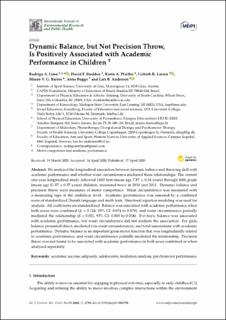| dc.contributor.author | Lima, Rodrigo Antunes | |
| dc.contributor.author | Stodden, David F. | |
| dc.contributor.author | Pfeiffer, Karin Allor | |
| dc.contributor.author | Larsen, Lisbeth Runge | |
| dc.contributor.author | Barros, Mauro V. G. | |
| dc.contributor.author | Bugge, Anna | |
| dc.contributor.author | Andersen, Lars Bo | |
| dc.date.accessioned | 2020-12-07T08:32:15Z | |
| dc.date.available | 2020-12-07T08:32:15Z | |
| dc.date.created | 2020-08-29T20:04:15Z | |
| dc.date.issued | 2020 | |
| dc.identifier.citation | Lima, R. A., Stodden, D. F., Pfeiffer, K. A., Larsen, L. R., Barros, M. V. G., Bugge, A., & Andersen, L. B. (2020). Dynamic balance, but not precision throw, is positively associated with academic performance in children. International Journal of Environmental Research and Public Health, 17(8). | en_US |
| dc.identifier.issn | 1661-7827 | |
| dc.identifier.uri | https://hdl.handle.net/11250/2712079 | |
| dc.description.abstract | We analyzed the longitudinal association between dynamic balance and throwing skill with academic performance and whether waist circumference mediated these relationships. The current one-year longitudinal study followed 1020 first (mean age 7.87 ± 0.34 years) through fifth grade (mean age 11.87 ± 0.37 years) children, measured twice in 2010 and 2011. Dynamic balance and precision throw were measures of motor competence. Waist circumference was measured with a measuring tape at the umbilicus level. Academic performance was assessed by a combined score of standardized Danish language and math tests. Structural equation modeling was used for analysis. All coefficients are standardized. Balance was associated with academic performance when both sexes were combined (β = 0.126, 95% CI: 0.074 to 0.179), and waist circumference partially mediated the relationship (β = 0.021, 95% CI: 0.008 to 0.034). For boys, balance was associated with academic performance, but waist circumference did not mediate the association. For girls, balance presented direct, mediated (via waist circumference), and total associations with academic performance. Dynamic balance is an important gross motor function that was longitudinally related to academic performance, and waist circumference partially mediated the relationship. Precision throw was not found to be associated with academic performance in both sexes combined or when analyzed separately. | en_US |
| dc.language.iso | eng | en_US |
| dc.publisher | MDPI | en_US |
| dc.rights | Navngivelse 4.0 Internasjonal | * |
| dc.rights.uri | http://creativecommons.org/licenses/by/4.0/deed.no | * |
| dc.subject | academic success | en_US |
| dc.subject | adiposity | en_US |
| dc.subject | adolescents | en_US |
| dc.subject | mediation analysis | en_US |
| dc.subject | psychomotor performance | en_US |
| dc.title | Dynamic balance, but not precision throw, is positively associated with academic performance in children | en_US |
| dc.type | Peer reviewed | en_US |
| dc.type | Journal article | en_US |
| dc.description.version | publishedVersion | en_US |
| dc.rights.holder | © 2020 by the authors | en_US |
| dc.source.pagenumber | 1-10 | en_US |
| dc.source.volume | 17 | en_US |
| dc.source.journal | International Journal of Environmental Research and Public Health (IJERPH) | en_US |
| dc.source.issue | 8 | en_US |
| dc.identifier.doi | 10.3390/ijerph17082790 | |
| dc.identifier.cristin | 1825970 | |
| cristin.ispublished | true | |
| cristin.fulltext | original | |
| cristin.qualitycode | 1 | |

